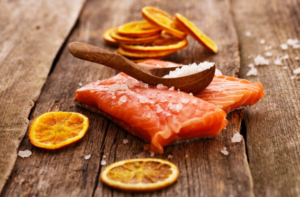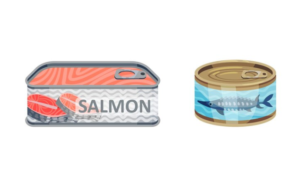Baking salmon is one of the best techniques in which the fish has been cooked. Baked salmon is known for its fantastic taste and soft textures. When perfectly prepared, baked salmon can enhance the taste of a meal tremendously.
How come the rest of us bake salmon at 400 degrees? If this question has puzzled you, know that you are not the only one! This is in view of the fact that several home cooks aim at achieving the perfect mixture of a well-baked exterior and a moist interior.
It helps to know the correct baking length, especially when either making dinner on a weekday or hosting friends/family and wanting to impress them.
In this article, we shall look at all the details of how to bake salmon including tips on how to pick fresh fillets and how to cook them perfectly.

The basics of baking salmon
Baking salmon is a simple technique and the end product is always delicious. The most essential factor is to use fresh fish of high quality. Look for fillets that are bright in color and do not have a strong smell.
Set oven temperature at four hundred before taking off the pan that is heating. This temperature will reach an equilibrium between adequate cooking times and a nice brown on the crust.
Use a small amount of oil to grease the surface of the baking dish you intend to use or place a piece of parchment paper at the bottom for easy cleaning. Put the salmon such that the skin is at the bottom and season it to your liking. Just plain salt and pepper are very effective, but there are better options out there.
Spoon the salmon pieces with a fork until it crumbles easily, usually around 12 to 15 minutes depending on how thick the piece is. When those last few minutes come, don’t be too far away from the oven; the cooking process of such a delicate fish can easily go overboard and can get very dry. Now that you have gotten a hold of the basics, it is easy to achieve the perfect salmon every single time.
Related Articles:
- How Long is Cooked Salmon Good For? Your Ultimate Storage Guide
- How to Smoke Salmon at Home: A Perfect Guide for 2024
- Can You Freeze Smoked Salmon?
Tips for buying and preparing salmon
When it comes to salmon, the most important thing is to make sure it is fresh. The skin is of a good bright color, ideal without any boring spots. The flesh should also be moderately firm to the touch and spring back slightly when pressed.
Salmon can also be sourced from different locations. It is believed that wild salmon tastes better than farmed varieties, but it is more costly and has a strong taste. If it is important to you, check the labels. Look for the MSC or A Sc labels, which indicate that they are certified.
To start, let’s focus on preparing the fish. First, fillets should be rinsed and dried off thoroughly, and patted with paper towels.
Never forget to season! Simply seasoning the fish with salt and pepper will enhance its rich natural taste. Also, it may be helpful to lightly marinate it in olive oil or lemon juice for half an hour for more taste without being too overpowering to the subtleness of the fish.
The importance of cooking temperature and time
Preparation methods that include cooking temperature and time once again become critical components in the preparation of salmon. They affect the texture, taste, and quality of the fish as a whole. People will, however, not be disappointed with salmon baked at 400 degrees Fahrenheit as it cooks all the components without leaving any of them dry.
This method not only allows for fully cooked salmon meat but also the surface of the meat becomes slightly crispy. That’s the sweet spot that needs to be achieved to get the right amount of chewy texture.
However, if you’re short on time and decide to decrease the cooking time or change the temperature of your oven, you’re going to be in a lot of trouble. For starters, salmon meat is rich in fat and can be dangerously undercooked, if this is the case. Overcooked fish lose its incredible taste and become chewy.
Being aware of both aspects will turn an ordinary dish into an exceptional one. For instance, knowing how long to bake salmon at 400 degrees is a great confidence when making tasty meals.
A step-by-step guide to baking salmon at 400 degrees
Turn on the oven to 400 degrees Fahrenheit. This is the optimum temperature range for even coziness of the salmon.
Before the oven time, let’s prepare the baking dish for the salmon. Place a piece of parchment paper in the bottom of the baking dish, or pour a tiny amount of olive oil into the dish and spread it throughout the surface. This helps in making things easier, as they do not stick and save the hassle of cleaning later on.
Next, put the salmon fillets in the dish with the skin side down. There is no rule for salt and pepper, put it undeniably and pleasantly as it enhances the taste.
For more tangy flavor, add some lemon slices, and top it with herbs or garlic. Spice it up!
When it is all ready to go, place the baking dish in the oven which was preheated. Time the cooking for approximately twelve to fifteen minutes based on how thick the fish is.
Watch it closely; that flakiness one loves is lovely, but overcooking is something we want to avoid! Once done, wait a couple of moments and then serve it.
Alternative methods for cooking salmon
There are many things that you can do other than bake the salmon you love the most. One of the most common techniques that people prefer is grilling, this lets you achieve those lovely deep char marks along with an infusion of smokey taste. Season your fillets and place them on medium-high heat, after about 6-8 minutes flip them to the next side and let them cook.
The method popularly referred to as ‘pan-searing’, allows the outside to get crispy while the inside remains soft and warm. Prepare some oil in a skillet and brown each side for 4-5 minutes based on thickness.
You can try poaching if ease is what you are after. This is a delicate technique that consists of cooking salmon by submerging it in water or broth until the color changes as it’s opaque – generally takes about 10 – 15 minutes.
For an unconventional option, consider sous vide. Still, vacuum-packing the salmon with herbs and spices, pour the vacuum-sealed package into a pot filled with water at the correct temperature so that you will have the desired outcome every time.
All of these methods will enhance the taste of your food differently, and you will be amazed!
How to tell when your salmon is done
To get your salmon out of the pan assertively when it’s time may not be so simple, but take heart, there are some methods that are quite foolproof.
First of all, look for the color. The color of the Salmon flesh changes from being translucent to the pparlorand with cooking this color becomes opaque. This indicator is always the best way to determine one’s cooking Chelsea supremes notes class 0.
Secondly but lastly, use a fork to gently press and test the thickest section of the fillet to the center of the fish. If the wine flakiness of salmon separates it is good to go.
Another way is using a food thermometer. Cooked salmon is best served at an internal temperature of about 145°F (63°C). Without touching any bone or flesh, insert the probe into the thickest part of the muscle to get the best results.
Do consider the resting time once the dish is out of the oven. Allow it to rest on the cutting board for approximately five minutes before it is sliced and served in order to allow juices to be distributed throughout the fish. Savor your chestnut-stuffed salmon!
Serving suggestions and side dishes
The ingredients used to prepare baked salmon extend to a boundless range of delectable tastes. Plating your dish with a side salad is a great way to enhance the appearance of your food. For instance, use some lettuce mix, cherry tomatoes, and baby greens with some light vinaigrette sauce.
Another wonderful addition is roasted vegetables. Zucchini, asparagus, or brussel sprouts would be a great complement to the salmon with its rich taste.
Or pair it with quinoa which is better served with something heartier like wild rice. These particular grains complement groups fantastically and successfully absorb the flavors.
Also, remember the sauces! For healthier options and to make the dish more interesting, you can use any of the garnishes like lemon-dill sauce or mango salsa sauce.
To make the dish more homely, serve along with creamy mashed potatoes which are quite rich indeed.
Conclusion
Baking salmon at 400 degrees Fahrenheit is a straightforward way to achieve a delicious meal. With the right preparation and cooking techniques, you can enjoy perfectly cooked salmon that’s both healthy and flavorful.
Remember to select fresh fish from reliable sources, paying attention to its color and texture. The right cooking time will vary depending on the thickness of your fillet but generally aim for about 12-15 minutes in the oven.
Explore different flavor profiles by experimenting with herbs, spices, or marinades. If you’re feeling adventurous, try alternative methods like grilling or poaching for variety in your meals.
Always check for doneness by observing the flesh’s color and flakiness—this ensures you serve up a satisfying dish every time. Pair your baked salmon with colorful vegetables or hearty grains to round out your plate beautifully.
With these tips in hand, baking salmon at 400 degrees will soon become one of your go-to recipes for easy weeknight dinners or special occasions alike. Enjoy every bite!



